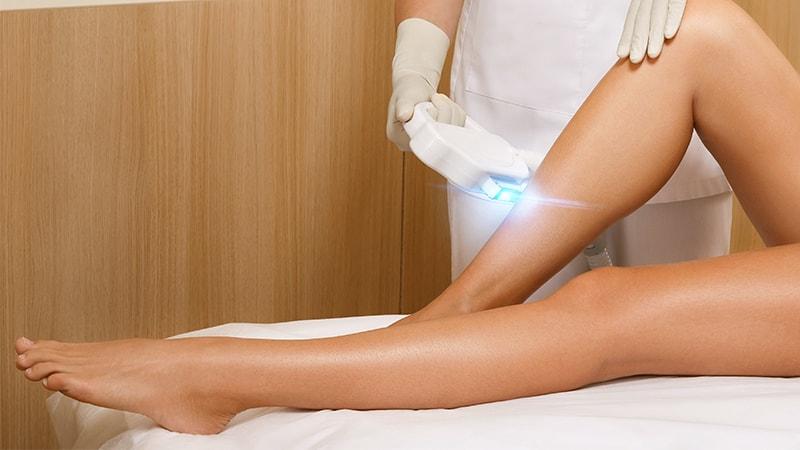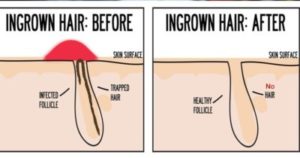Laser Hair Removal Ingrown Hairs … Can the First Solve the Second?

With traditional hair removal methods, a lot of problems can simply happen, but Laser Hair Removal ingrown hairs have been a famous solution to the not-properly-shaved body parts.
Shaving, waxing, and trimming have been a part of our daily life, but those traditional methods cause what we call “ingrown hairs.”
What are ingrown hairs? Why do they happen? How to get rid of them? And what instructions are there to prevent them from appearing again? Our experts shall answer you in this article.
Professionals say that Laser hair removal is the best and only real effective choice for getting rid of ingrown hairs quickly, we shall also discuss this in-depth.
- What are Ingrown Hairs?
- How Do I Know If I Have Ingrown Hair?
- Where do I generally find ingrown hair?
- Why Should I remove the ingrown hairs?
- Solution? Laser Hair Removal Ingrown Hairs
- Ingrown Hair After Laser: How does it look?
- How Many Treatments Do You Need to Complete Ingrown Hairs Permanently?
- What to do in order to NOT face ingrown hairs after laser hair removal?
What are Ingrown Hairs?
Ingrown Hair is a hair follicle that produces hair unable to push its way through the outer layer of skin.
Hair can’t grow up towards its usual route? It’ll grow sideways then, causing real issues to the skin, and the body part that had this problematic hair follicle.
Is this the only way a hair goes ingrown? No. sometimes it’ll just become trapped under the skin before leaving the follicle itself, and other times it’ll grow out of the follicle and the skin, then curl itself back and reenter the skin layer, but it’s a rare occasion.

How Do I Know If I Have Ingrown Hair?
On a general note, ingrown hair will appear like a little pimple (or red bumps) on your skin, it’ll feel sensitive, and it’ll hurt to just touch it.
You may also notice something that looks like a sore or boil.
For some people, it’ll feel itchy around that area, and the whole circle around that ingrown hair will feel bitter and uncomfortable.
Where do I generally find ingrown hair?
Ingrown hairs happen more often to those with naturally curly hair or coarse hair, and they can happen anywhere on the body because our bodies are covered in hair.
But areas that are shaved have a higher propensity.
The most typical areas for ingrown hairs to occur are on the face, neck, armpits, back, and chest, or in the pubic area.
While it’s more common among men, it’s still an issue waiting to be addressed for both men and women.
Why Should I remove the ingrown hairs?
We already mentioned that it causes a lot of problems to the skin, especially the fact that it stays itchy and red, which can also affect how your body part looks, most importantly: your face.
Ingrown hairs cause infection. It penetrates the outer skin, damaging both the beneath and outer layers.
Dermatologists confirmed that it’s crucial to get rid of ingrown hairs, to avoid such infections and any additional skin problems.
There’s some evidence to suggest that ingrown hairs can lead to more serious conditions such as a pilonidal cyst.
What is that? Pilonidal cysts usually appear near the tailbone.
They are pockets filled with dead skin cells and hair. Pilonidal cysts are painful and typically need to be surgically removed or drained. Unlike ingrown hairs, there is very little chance of pilonidal cysts going away on their own.
Solution? Laser Hair Removal Ingrown Hairs
Looking for a permanent solution to ingrown hairs? We got you covered!
The first solution that came to mind was: Waxing. Why? Ingrown hairs occur when you cut the growing hair into pieces, the outer part is removed while the inner part causes problems.
So, why not just pluck it out with waxing? It’ll remove the hair fully, without cutting it into pieces.
Actually, it’s a decent idea, but it doesn’t 100% of the times work, as sometimes even the wax does break a hair or two.
Moreover, Waxing will only remove the hair, but it’ll grow again causing the same problems once more.
By contrast, Laser hair removal is another perfect solution. Why? Now we shall explain how Laser hair removal with ingrown hairs is a long-lasting solution to this matter.
Laser hair removal of ingrown hairs does 3 important tasks:
- Remove ingrown hairs as shown in this video: https://www.youtube.com/watch?v=k5OFK4WxssI
- Slow the hair growth exceptionally making hairs take longer to grow and cause problems
- Works every time on every hair follicle instead of a sub-100% success rate.
Once the follicle can no longer produce hair after laser hair removal treatment of ingrown hairs, the affected area will begin to heal.
It’s important to remember that the problem with ingrown hairs isn’t just the one-time production of hair that pierces back into your skin causing irritation. The real issue is that the hair will keep coming back and continuing to grow while stuck underneath the skin.
By using laser hair removal on ingrown hairs, you’re stopping the hair follicle from producing hair now and in the future.
This method shall put matters to bed when dealing with irritation, infections, discomfort, and itchy skin.
Ingrown Hair After Laser: How does it look?
If you’ve watched the video we’ve just linked to, you’ll see how it looks like in real life, to have laser ingrown hair removal.
However, this graph shall also give you the look from a horizontal point of view:

How Many Treatments Do You Need to Complete Ingrown Hairs Permanently?
It’s very well known that the number of laser sessions –at home or clinical – varies from a person to another.
However, the same rule that applies to normal laser hair removal sessions, apply to sessions that remove ingrown hairs.
This means, that you’ll need between 6-10 treatments spaced 4-6 weeks apart, to complete your treatment.
You’ll notice a significant decrease in ingrown hair bumps after laser hair removal.
What to do in order to NOT face ingrown hairs after laser hair removal?
Exfoliate
Exfoliating removes dead skin cells from the outer layer of the skin. And it’s those dead skin cells that cause the hair to get clogged in the first place.
With that being said, It’s essential to use an exfoliator wherever hair grows, to prevent ingrown hairs from getting stuck inside the skin.
Don’t Shave too much
Shaving increases the risk of creating ingrown hairs’ situation.
Shaving as little as you can, should decrease the possibility of creating that dire situation.
And when you do shave, use a shaving cream or gel on the area.
Also, shave in the proper direction, as shaving in the direction the hair grows is an essential part of stopping ingrown hairs in their tracks.
Shaving in the opposite direction will cause the hairs to be cut at a sharper angle, and sharply cut hairs are more likely to become ingrown.
Use Sharp Well-known razors
Shave with a sharp, fresh blade and use a single-blade razor for the best results.
If you can live without a super smooth shave, switch to an electric razor.
This will give you a close shave but leaves the tip of the hair above your skin’s surface.
As long as the edge of the hair is above the surface of the skin, it won’t be able to curl around and grow inwards.